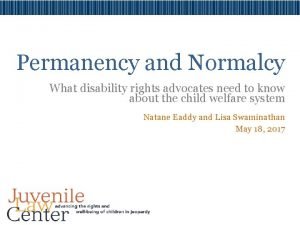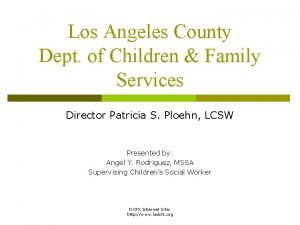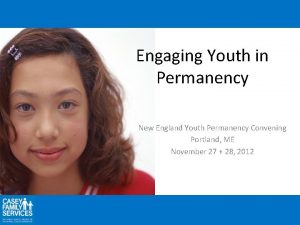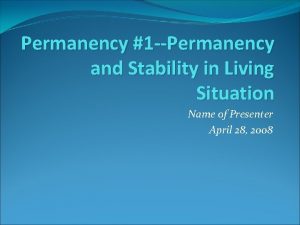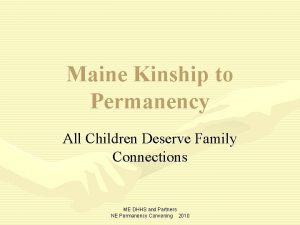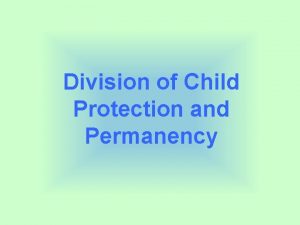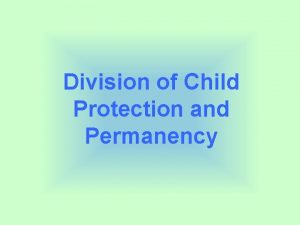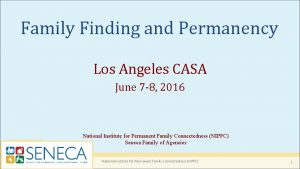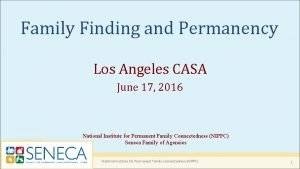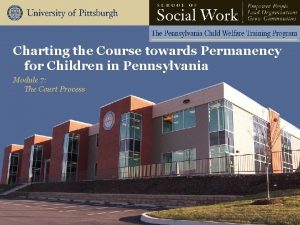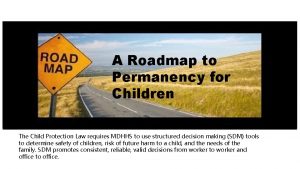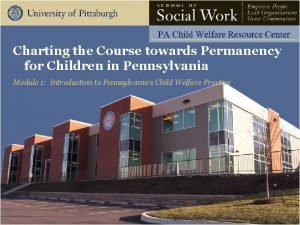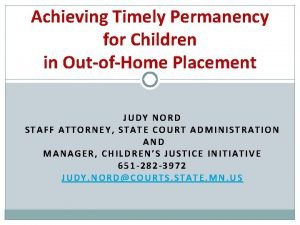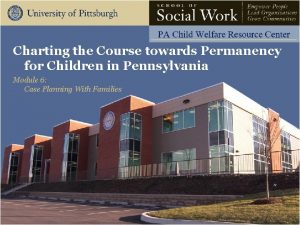PERMANENCY FOR CHILDREN Division of Family Children Services




















































- Slides: 52

PERMANENCY FOR CHILDREN Division of Family & Children Services July G-Force Meeting July 30, 2009

END OF G -- QUESTION If G-Force is to be an environment for hypothesis testing and critical thinking, what will you do differently as a result of participating in this G-Force Meeting?

AGENDA • Permanency for Children at Every Stage • Family Preservation Analyses • Safety Resource Review: Ron Magbee & The FAST Team • Permanency Planning for Children • Permanency Roundtable Success Stories • Office of Family Independence

SHIFT OF PARADIGM FOR PERMANENCY INEFFECTIVE LENS - Incident-Based - Child-Focused - Placement-Driven (Ineffective for accomplishment of today’s outcomes) EFFECTIVE LENS - Comprehensive Assessment of Strengths & Challenges - Family-Centered - Permanency-Driven Permanency Pathways 4

BUSINESS MODEL s w a L PATHWAYS En Fa e v i ga mi s n t ge ly e m eh men Individualized en r p ss Service t m e o C Ass Planning nt e rr g u nc nin o C lan P In Y vo ou lv th em en Financial t Policies & Procedures State Statutes PERMANENCY

PERMANENCY FOCUS AT EVERY STAGE Preserve Safe & Thriving Forever Families Children Safe & Thriving in Forever Families Sooner Family Safety Foster Investigation Support Preservation Resource Family IN - HOME HYBRID OF BOTH Group Home CCI OUT-OF-HOME PRTF After Care IN HOME 6

SHIFT OF PARADIGM FOR G-FORCE INEFFECTIVE LENS Single Data Points (Ineffective for decision-making) EFFECTIVE LENS - Comprehensive View of Practice - Data Chains Reflecting Practice Permanency Pathways 7

DATA COLLECTION, MEASUREMENT & ANALYSIS OF PERMANENCY PATHWAYS PERMANENCY How might we measure and analyze Permanency Pathways? PATHWAYS e iv En Fa s n t ga mi e n h e ge ly e m pr ssm en m e Individualized o t C Ass Service Planning nt e r r cu ing n Co lann P In Y vo ou lv th em en t

EXAMPLE: TIMELINESS OF INITIATING INVESTIGATIONS OUTCOME S 1: 84. 92% According to the Quality Case Review Report from Program Evaluation & Analysis Unit (PEAS), our timeliness of initiating investigations of reports of child maltreatment was at 84. 92%; however, our SHINES data reflects 94. 7% for January – June 2009. Why is there such a wide variation between these two reports? SHINES data only reflects one data point whereas the PEAS unit reviews several elements to determine the actual timeliness rate. 9

The low timeliness rates from September 2008 – December 2008 appear to be a result of staff not understanding how to correctly code the information in SHINES.

BEYOND SINGLE-DATA POINTS TO DATA-CHAINS DATA CHAINS Data Points Data points only provide a small slice of information and are not able to provide the context needed to test hypotheses; we must use data chains instead. These data chains should be a compilation of data points related to a particular event. • Finish the Drill: Start from the beginning with the data and take it through. • Answer the question: Is what we did enough to move the needle? 11

PERCENTAGE OF FAMILY PRESERVATION CASES OPENED DURING SFY 2009 THAT HAD A PRIOR REPORT OF ABUSE/NEGLECT Statewide: 86. 2% Statewide, 86. 2% of the family preservation cases opened during SFY 2009 had a previous report of abuse/neglect associated with it. 12

PERCENTAGE OF CHILDREN WHO ENTERED FOSTER CARE IN SFY 2009 FROM FAMILY PRESERVATION SERVICES Statewide: 30% Question: How do we know that children in Regions 12, 15, 16 & 17 are safe and thriving? 13

PERCENTAGE OF CHILDREN WHO ENTERED FOSTER CARE IN SFY 2009 FROM FAMILY PRESERVATION SERVICES BY REGION FROM LOWEST TO HIGHEST State Average 30% Note: The majority of children who came into care in Regions 15, 16, 17, 12, 14, 13 & 7 were not receiving Family Preservation services. These regions are either metro areas or have large metropolitan 14 areas such as Region 12 (Chatham County) and Region 7 (Richmond County).


TIMELY COMPLETION OF INVESTIGATIONS SFY 2004 – SFY 2009 16

SUBSTANTIATED & CLOSED INVESTIGATIONS WITH NO FURTHER DFCS INVOLVEMENT July 2008 – May 2009 • Follow-Up Questions How many of these families received OFI services? • How many of these families experience a recurrence of maltreatment? • What maltreatment types are most often presented in these cases? Note: Two of the most common reasons investigations are substantiated and closed with no further DFCS involvement are that the alleged perpetrator no longer has access to the child, and/or the family is already receiving services or involved with community resources and risk to children has been reduced or eliminated. 17


MALTREATMENT TYPES ASSOCIATED WITH FAMILY PRESERVATION CASES OPENED IN SFY 2009 (N=9, 195) Alleged Maltreatment Percent of Total Cases Inadequate Supervision 56. 2% Inadequate Food, Clothing, Shelter 18. 9% Bruises, Welts, Abrasions 14. 9% Emotional/Psychological Neglect 14. 0% Inadequate Health, Medical Care 9. 1% Domestic Violence 7. 9% Birth Addicted/Birth Exposed 6. 7% Fondling 4. 1% Verbal Threats/Abuse 3. 5% Educational/Cognitive Neglect 3. 3% Abandonment/Rejection 3. 2% Note: Less than one percent of cases were opened for other alleged maltreatments such as corporal punishment, malnourishment, sexual exploitation, etc. Also note that percentages do 19 not add up to 100% because there was more than one maltreatment type in many instances.

MALTREATMENT TYPES & AVERAGE NUMBER OF MONTHS FAMILY PRESERVATION IN SFY 2009 IN Average time: 4. 2. Note: The maltreatment type does not appear to impact the number of months a case is open. How would this be different if we were applying Pathways to Permanency? 20

PRIOR SUBSTANTIATION & AVERAGE NUMBER OF MONTHS FAMILY PRESERVATION CASES WERE OPEN IN SFY 2009 Note: Cases with prior substantiations tended to be open longer in Family Preservation than those without. 21

FAMILY PRESERVATION, FOSTER CARE & SAFETY RESOURCES (N=9, 195) • Five percent (5%) or 454 of the Family Preservation cases opened in SFY 2009 consisted of children who had previously been in foster care (697 children). • The average time from the child’s exit from foster care to the opening of the Family Preservation case was 42 months. • Twenty-four percent (24%) of the Family Preservation cases opened during SFY 2009 had a safety resource stay for one or more children. 22




PERMANENCY PLANNING FOR CHILDREN • The goal of permanency planning is to provide children with safe and stable environments in which to grow up, while in the care of a nurturing caregiver, committed to a life long relationship with them. • A sense of urgency must exist for every child who is not in a permanent home. Source: Permanency Planning Practice Guide for Social Workers. Children’s Administration, August 2006. 26

PERMANENCY FOR CHILDREN • Starts at first contact • Continues throughout the lifetime of the child’s case until permanency is reached, • Secures a safe, stable and permanent home for the child as soon as possible, • Protects/maintains primary attachments and/or creates new attachments, and • Preserves cultural and family connections. Source: Permanency Planning Practice Guide for Social Workers. Children’s Administration, August 2006. 27

WHAT A DIFFERENCE A ROUNDTABLE MAKES!! Permanency roundtables held from January 2009 through July 2009 with approximately 2, 179 children.

NUMBER OF CHILDREN BY REGION January 2009 – July 2009 Note: There were 2, 078 children from permanency roundtables matched with SHINES records. The remaining 101 children not matched due to problems identifying them in SHINES because of limited information received regarding them. 29

PLACEMENT TYPE FOR CHILDREN IN ROUND TABLE (N=2, 078) • CPA Foster Home: 27. 6% • DFCS Foster Home: 23. 2% • CCI: 17. 5% • Group Home: 10. 4% 30

PERMANENCY PLAN FOR CHILDREN IN ROUND TABLE (N=2, 078) • Adoption: 30. 4% • Reunification: 28. 8% • Emancipation: 18. 1% • Long Term Foster Care: 11. 8% • Placement with Relatives: 9. 4% 31

COMPARISON OF AGE & TIME IN CARE OF CHILDREN IN PERMANENCY ROUNDTABLE WITH OVERALL FOSTER CARE POPULATION IN GEORGIA AGE DAYS IN CARE AVERAGE FOR ROUNDTABLE 10. 8 1, 498 AVERAGE FOR FOSTER CARE POPULATION 8. 8 612 MEDIAN FOR ROUNDTABLE 12. 0 1, 254 MEDIAN FOR FOSTER CARE POPULATION 8. 0 470 Overall, children were in care for an average of 612 days and a median of 470 days from January through June 2009 as compared to higher averages and medians for children who were round-tabled. 32

POSITIVE PERMANENCY EXITS (N=212) Note: 10% of children who were round-tabled have exited care to Positive Permanency since January 2009. 33

ROUNDTABLE SUCCESSES • Children 16 & over • Children in care for 48 months or more • Siblings in care • Children with physical and behavioral health needs • Paternal Connections 34

Region 10 16 year-old moved from group home to foster home after 2 years. FP seeking Guardianship 16 year-old confined to a wheelchair being adopted by foster parent Region 8 16 year-old in foster care for 5 years received permanency through guardianship with foster parents Region 9 17 year-old reconnected with Mother after 8 years (divorce) CHILDREN 16 & OVER Region 12 17 year-old moved from group home; being adopted by former group home staff member

Region 13 17 year-old in care since 2005 obtained permanency with uncle 11 year-old in care for 9 years in residential facility; foster parent now identified who will adopt child Region 3 14 year-old in care for 77 months now in an adoptive home CHILDREN IN CARE FOR 48 MONTHS OR MORE Region 9 17 year-old in care since 1997, being adopted by Therapeutic Foster Parent Child reunited with mother after 4 years in care; permanency goal had been emancipation

Region 3 Region 4 12 and 13 year-old siblings in care for 7 years are now with grandmother awaiting guardianship Sibling group of 5 in care for 20 months, in two different settings, are now in the home of a relative awaiting transfer of custody SIBLINGS ACHIEVING PERMANENCY TOGETHER! Region 3 Sibling group of two (13 & 14) in care for 122 months will obtain permanency through guardianship with foster parent Region 2 Region 4 Finalized adoption on June 29, 2009 for three siblings Sibling group of two (12 & 13) in care for 48 months transitioned into an adoptive home in July

Region 4 Region 13 14 year-old in care for 7 years with long-term PRTF & MRBWO placements reunified with mother on July 7, 2009 Siblings in care since 2001 with severe medical and behavioral health needs now in home of former group home staff via guardianship CHILDREN WITH PHYSICAL & BEHAVIORIAL HEALTH NEEDS Region 3 14 year-old with an infant, and has been in 16 different placements, now moving toward adoption by foster parent Region 16 16 year-old in care for 22 months after an adoption disruption was reunited with adoptive parents after long-term PRTF placement

PATERNAL CONNECTIONS • Father and other paternal relatives located for a child who has been in care for 64 months; father wants custody of child (Region 1). • Father granted custody of a 22 -month old who has been in care since birth on June 25, 2009 (Region 4). • Father granted custody of a 3 year-old who has been in care since birth (Region 16). PATERNAL FAMILY An aunt and paternal grandmother located through Accurint search for a 17 year-old, in care since 1995. Both want to establish a relationship with the child (Region 9).

What practice changes did we improve to get these success stories? Excluding positive permanency exits, how can we measure success? 40


CHARACTERISTICS OF CHILDREN IN CARE June 2009 • Average days in care is 598 • Median days in care is 437 (488 in June 2008) • 84. 9% had only one foster care entry and 12. 4% had two • Average = 8. 8 years; median = 8 years 42

What practice chain resulted in rates we see in Region 17 and Region 6? What resources are necessary to impact this measure?

FOSTER CARE ENTRIES, EXITS & RE-ENTRY RATES SFY 2004 – SFY 2009 National Standard = 8. 60% or less The number of children exiting foster care continues to outpace those entering care. In addition, the foster care re-entry rate for SFY 2009 is almost half of what it was in SFY 2007. As more children exit foster care, fewer are returning. 44

FOSTER CARE ENTRIES, EXITS & RE-ENTRY RATES July 2008 – June 2009 National Standard = 8. 60% or less Note: Foster care reentry rate is slightly higher for February and March than was reflected in previous G-meetings due to late entry of data needed for calculation of the rate. 45

What is the relationship between length of time to achieve reunification and foster care re-entry?

OFFICE OF FAMILY INDEPENDENCE 47

As of July 9, 2009



OFI Performance Management Under Construction 51

END OF G -- QUESTION If G-Force is to be an environment for hypothesis testing and critical thinking, what will you do differently as a result of participating in this G-Force Meeting?
 Permanency plan example
Permanency plan example Child welfare services
Child welfare services Long division and short division
Long division and short division How to synthetic division
How to synthetic division Division is the short form of repeated
Division is the short form of repeated Synthetic dovision
Synthetic dovision Monica yuskaitis
Monica yuskaitis Kontinuitetshantering i praktiken
Kontinuitetshantering i praktiken Typiska novell drag
Typiska novell drag Nationell inriktning för artificiell intelligens
Nationell inriktning för artificiell intelligens Vad står k.r.å.k.a.n för
Vad står k.r.å.k.a.n för Varför kallas perioden 1918-1939 för mellankrigstiden
Varför kallas perioden 1918-1939 för mellankrigstiden En lathund för arbete med kontinuitetshantering
En lathund för arbete med kontinuitetshantering Särskild löneskatt för pensionskostnader
Särskild löneskatt för pensionskostnader Tidbok yrkesförare
Tidbok yrkesförare Anatomi organ reproduksi
Anatomi organ reproduksi Förklara densitet för barn
Förklara densitet för barn Datorkunskap för nybörjare
Datorkunskap för nybörjare Tack för att ni lyssnade bild
Tack för att ni lyssnade bild Mall för debattartikel
Mall för debattartikel Autokratiskt ledarskap
Autokratiskt ledarskap Nyckelkompetenser för livslångt lärande
Nyckelkompetenser för livslångt lärande Påbyggnader för flakfordon
Påbyggnader för flakfordon Lufttryck formel
Lufttryck formel Svenskt ramverk för digital samverkan
Svenskt ramverk för digital samverkan Jag har nigit för nymånens skära
Jag har nigit för nymånens skära Presentera för publik crossboss
Presentera för publik crossboss Argument för teckenspråk som minoritetsspråk
Argument för teckenspråk som minoritetsspråk Bat mitza
Bat mitza Treserva lathund
Treserva lathund Luftstrupen för medicinare
Luftstrupen för medicinare Bästa kameran för astrofoto
Bästa kameran för astrofoto Centrum för kunskap och säkerhet
Centrum för kunskap och säkerhet Verifikationsplan
Verifikationsplan Mat för unga idrottare
Mat för unga idrottare Verktyg för automatisering av utbetalningar
Verktyg för automatisering av utbetalningar Rutin för avvikelsehantering
Rutin för avvikelsehantering Smärtskolan kunskap för livet
Smärtskolan kunskap för livet Ministerstyre för och nackdelar
Ministerstyre för och nackdelar Tack för att ni har lyssnat
Tack för att ni har lyssnat Referat mall
Referat mall Redogör för vad psykologi är
Redogör för vad psykologi är Borstål, egenskaper
Borstål, egenskaper Atmosfr
Atmosfr Borra hål för knoppar
Borra hål för knoppar Orubbliga rättigheter
Orubbliga rättigheter Beräkna standardavvikelse
Beräkna standardavvikelse Tack för att ni har lyssnat
Tack för att ni har lyssnat Rita perspektiv
Rita perspektiv Vad är verksamhetsanalys
Vad är verksamhetsanalys Tobinskatten för och nackdelar
Tobinskatten för och nackdelar Toppslätskivling dos
Toppslätskivling dos Handledning reflektionsmodellen
Handledning reflektionsmodellen
